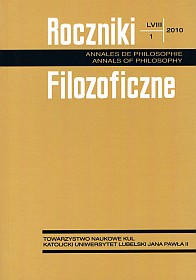Name Negation versus Indefiniteness and Vagueness of Concepts
Abstract
The author refers to the construction that includes two types of negation – external (~) and internal (). When we consider an object belonging to a given universe and a given set of predicates, some of them belong to it, and others do not. There may also be such predicates about which it cannot be sensibly stated that they belong to the object – and this is the third case (vagueness) that can be explained by such a construction. It is a non-classical theory of predication. In the classical theory of predication (whose standard realization is the classical predicate calculus) we only have one negation operator (external negation).
The idea may be transferred to the calculus of names. In the article a certain broadening of elementary ontology is suggested, where analogous distinctions among predication operators and name negation allow (from the meta-linguistic perspective) perceiving the phenomenon of indefiniteness (vagueness) of names in a new light.
References
Dąmbska I.: Niektóre pojęcia gramatyki w świetle logiki, [w:] Szkice filozoficzne. Romanowi Ingardenowi w darze, Warszawa–Kraków: PWN 1964.
Kubiński T.: Nazwy nieostre, „Studia Logica” 7 (1958), s. 115-175.
Pawłowski T.: Tworzenie pojęć w naukach humanistycznych, Warszawa: PWN 1986.
Sinowjew A.: Nichttraditionelle Quantorentheorie, [w:] Quantoren-Modalitäten-Paradoxien. Beiträge zur Logik, hrsg. H. Wessel. Berlin 1972, s. 179-205.
Sinowjew A., Wessel H.: Logische Sprachregeln, Berlin 1975.
Słupecki J.: St. Leśniewski’s protothetics, „Studia Logica” 1 (1953), s. 44-112.
Słupecki J.: St. Leśniewski’s calculus of names, „Studia Logica” 3 (1955), s. 7-70.
Stróżewski W.: Z problematyki negacji, [w:] Szkice filozoficzne. Romanowi Ingardenowi w darze, Warszawa–Kraków: PWN 1964.
Twardowski K.: O treści i przedmiocie przedstawień, [w:] tenże, Wybrane pisma filozoficzne, Warszawa: PWN 1965, s. 3-91.
Wessel H.: Logik, Berlin 1984.
Copyright (c) 2010 Roczniki Filozoficzne

This work is licensed under a Creative Commons Attribution-NonCommercial-NoDerivatives 4.0 International License.





